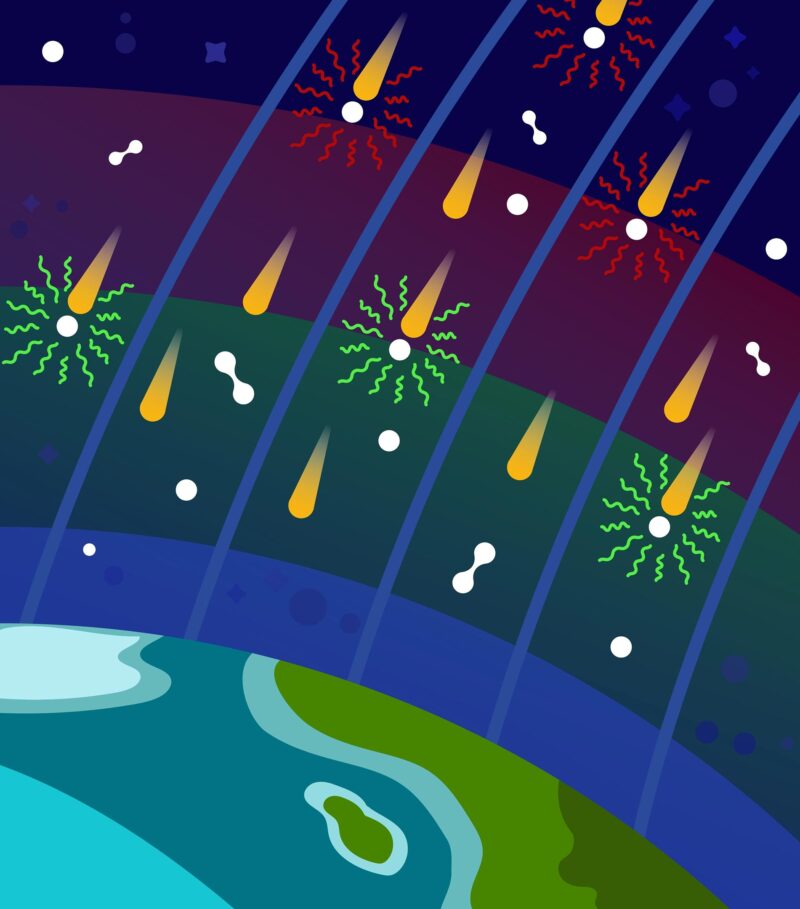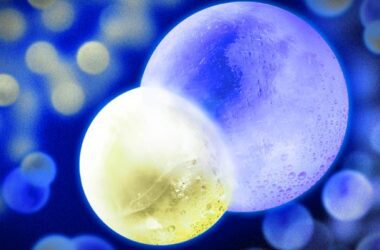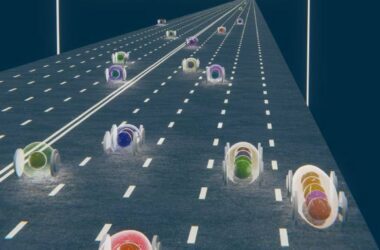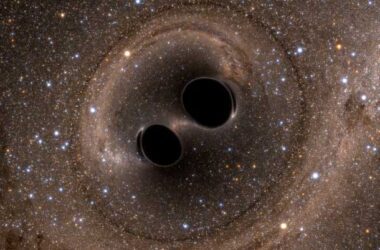Par

Lorsque les électrons accélérés par les ondes d’Alfvén se déplacent le long du champ magnétique de la Terre (gouttes jaunes), ils entrent en collision avec des atomes d’oxygène (points blancs) et des molécules d’oxygène et d’azote (haltères blancs), ce qui les fait émettre de la lumière et crée les aurores boréales. Crédit : Image reproduite avec l’aimable autorisation d’Austin Montelius, College of Liberal Arts and Sciences, Université de l’Iowa.
La science
De nouvelles expériences ont révélé la source des aurores boréales. Des ondes d’Alfvén accélérant des électrons dans des conditions similaires à celles observées dans la magnétosphère terrestre ont été mises en évidence par les scientifiques. Les particules chargées ionisées ou plasma, one of the four kinds of matter (along with solid, liquid, and gas), are found in the magnetosphere that surrounds the Earth. Plasmas have properties that are similar to both fluids and gases, but they also have magnetic and electric fields. Hannes Alfvén predicted in 1942 that plasmas could support waves. These waves are now known as Alfvén waves.
The latest experiments show that electrons “surf” on the Alfvén wave’s electric field, a phenomenon known as Landau damping. This means that the wave’s energy is transmitted to the accelerated electrons, much like a surfer catching a wave and being continuously accelerated as the surfer advances along with the wave. These electrons are the ultimate source of the aurora borealis’ illumination.
The Impact
Humanity has always been fascinated by the magnificent shimmering displays of the aurora borealis. Now scientists have demonstrated how electrons associated with the aurora accelerate towards the Earth, where they collide with molecules in the upper atmosphere. These collisions cause the emission of auroral light. The new research reproduced the conditions in space above the aurora in the laboratory. It shows that Alfvén waves launched by storms in the earth’s magnetic field can accelerate the electrons that cause the bright glow of the aurora. These results definitively confirm this previously unproven hypothesis.
Summary
The spectacular displays of the aurora borealis have always fascinated humankind. More recently, they have captured the attention of scientists curious to explain this phenomenon. Scientists know that electrons from space precipitate into the upper atmosphere and collide with atoms and molecules to produce auroral light. The cause of this electron precipitation has been an area of ongoing research.
One theory is supported by the fact that scientists regularly find powerful electromagnetic waves called Alfvén waves traveling toward the Earth above auroras. According to this theory, Alfvén waves accelerate electrons toward Earth, causing them to precipitate and produce auroras. Although space-based measurements provide strong support of this theory, the limitations of these measurements have prevented a definitive test.
To overcome these limitations, researchers performed laboratory experiments on the Large Plasma Device (LAPD) at University of California, Los Angeles (UCLA) Basic Plasma Science Facility, a national collaborative research facility supported jointly by the Department of Energy and the National Science Foundation. In a laboratory experiment that reproduced the conditions in Earth’s magnetosphere, the team launched Alfvén waves down the LAPD chamber and then measured the electrons accelerated by the electric field of the Alfvén waves.
Measurements revealed these particular electrons undergo resonant acceleration by the wave’s electric field, similar to a surfer catching a wave and being continually accelerated by the wave. This phenomenon of the energy of a wave transferring to accelerated electrons is known as Landau damping. The research team combines the measurements of the wave’s electric field and the electrons to generate a unique signature of the electron acceleration by Landau damping. Through simulations and modeling, they showed that the signature of acceleration measured in the experiment agreed with the predicted signature for Landau damping.
The agreement of experiment, simulation, and modeling provides the first direct test showing that Alfvén waves can produce accelerated electrons that cause the aurora.
For more on this discovery, see:
Reference: “Laboratory measurements of the physics of auroral electron acceleration by Alfvén waves” by J. W. R. Schroeder, G. G. Howes, C. A. Kletzing, F. Skiff, T. A. Carter, S. Vincena and S. Dorfman, 7 June 2021, Nature Communications.
DOI: 10.1038/s41467-021-23377-5
This research was supported by the Department of Energy Office of Science, the National Science Foundation, and the National Aeronautics and Space Administration. The Basic Plasma Science Facility is supported by a Cooperative Agreement through the Department of Energy and a grant through the National Science Foundation.



